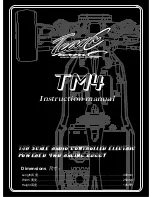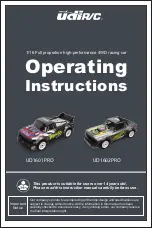
18 • SLASH 4X4 ULTIMATE
DRIVING YOUR MODEL
Now it’s time to have some fun! This section contains instructions on
driving and making adjustments to your model. Before you go on, here
are some important precautions to keep in mind.
• Allow the model to cool for a few minutes between runs. This is
particularly important when using high capacity battery packs that
allow extended periods of running. Monitoring temperatures will
extend the lives of the batteries and motors. See page 26 for advanced
user information on monitoring temperatures.
• Do not continue to operate the model with low batteries or you
could lose control of it. Indications of low battery power include slow
operation, sluggish servos (slow to return to center), or ESC shutdown
due to the Low-Voltage Detection circuitry. Stop immediately at the
first sign of weak batteries. When the batteries in the transmitter
become weak, the power light will begin to flash red. Stop immediately
and install new batteries.
• Do not drive the model at night, on public streets, or in large crowds of
people.
• If the model becomes stuck against an object, do not continue to run
the motor. Remove the obstruction before continuing. Do not push or
pull objects with the model.
• Because the model is controlled by radio, it is subject to radio
interference from many sources beyond your control. Since radio
interference can cause momentary losses of control, allow a safety
margin of space in all directions around the model in order to prevent
collisions.
• Use good, common sense whenever you are driving your model.
Intentionally driving in an abusive and rough manner will only result in
poor performance and broken parts. Take care of your model so that
you can enjoy it for a long time to come.
• When using the supplied optional pinion for top-speed running, limit
your driving to paved surfaces only. Running in grass and off-road
could cause excessive loads on the electrical system in the model.
• High-performance vehicles produce small vibrations that may loosen
hardware over time. Frequently check wheel nuts and other screws on
your vehicle to ensure that all hardware remains properly tightened.
About Run Time
A large factor affecting run time is the type and condition of your
batteries. The milliamp hour (mAh) rating of the batteries determines
how large their “fuel tank” is. A 3000mAh battery pack will theoretically
run twice as long as a 1500mAh sport pack. Because of the wide
variation in the types of batteries that are available and the methods
with which they can be charged, it’s impossible to give exact run times
for the model.
Another major factor that affects run time is how the model is driven.
Run times may decrease when the model is driven repetitively from a
stop to top speed and with repetitive hard acceleration.
Tips for Increasing Run Time
• Use batteries with the highest mAh rating you can purchase.
• Use a high-quality peak-detecting charger.
• Read and follow all maintenance and care instructions provided by the
manufacturer of your batteries and charger.
• Keep the VXL-3s cool. Get plenty of airflow across the ESC heat sink.
• Use the correct Low-Voltage Detection setting for your battery (see
page 16). Low-Voltage Detection can be off for maximum NiMH battery
runtime. Never use LiPo batteries while Low-Voltage Detection is
turned off.
• Maintain your model. Do not allow dirt or damaged parts to cause
binding in the drivetrain. Keep the motor clean.
• Lower your gear ratio. Installing a smaller pinion or larger spur gear
will lower your gear ratio, causing less power draw from the motor and
battery and reducing overall operating temperatures.
mAh Ratings and Power Output
The mAh rating of the battery can effect your top-speed performance.
The higher capacity battery packs experience less voltage drop under
heavy load than low mAh rated packs. The higher voltage potential
allows increased speed until the battery begins to become discharged.
9
















































